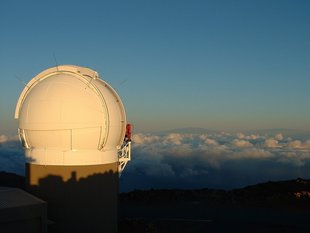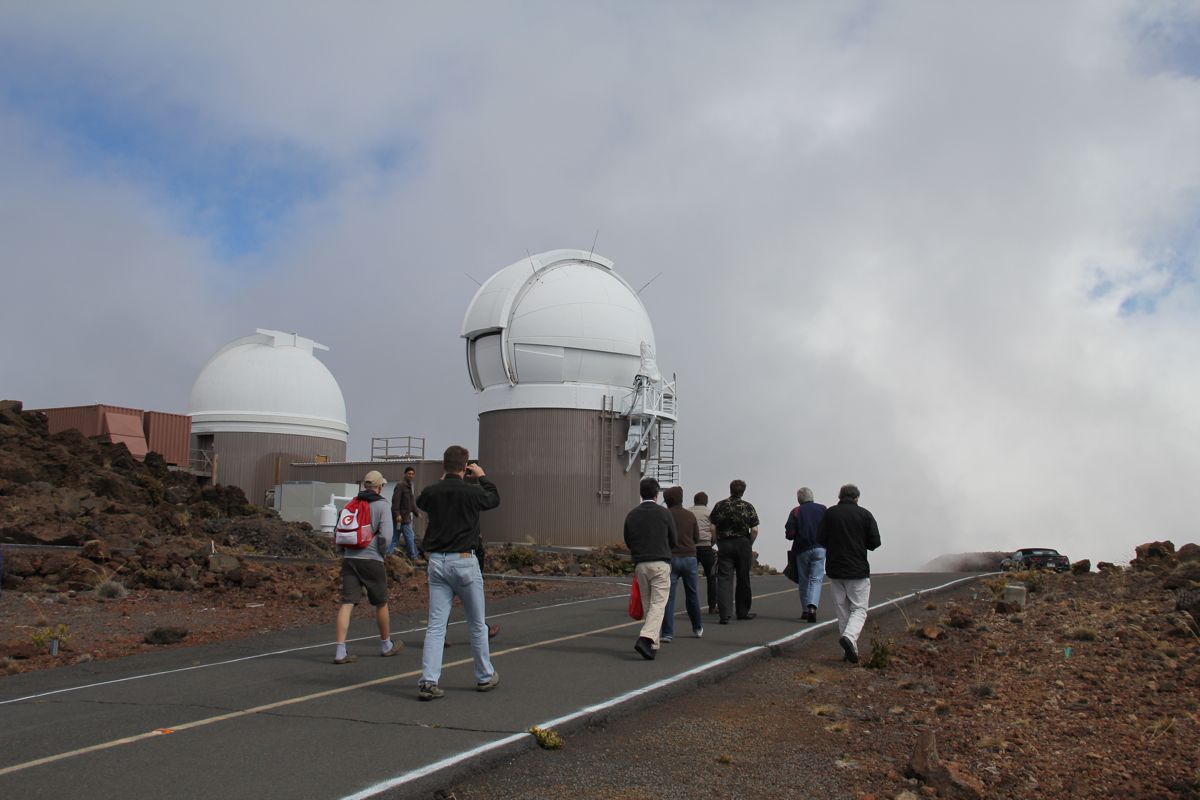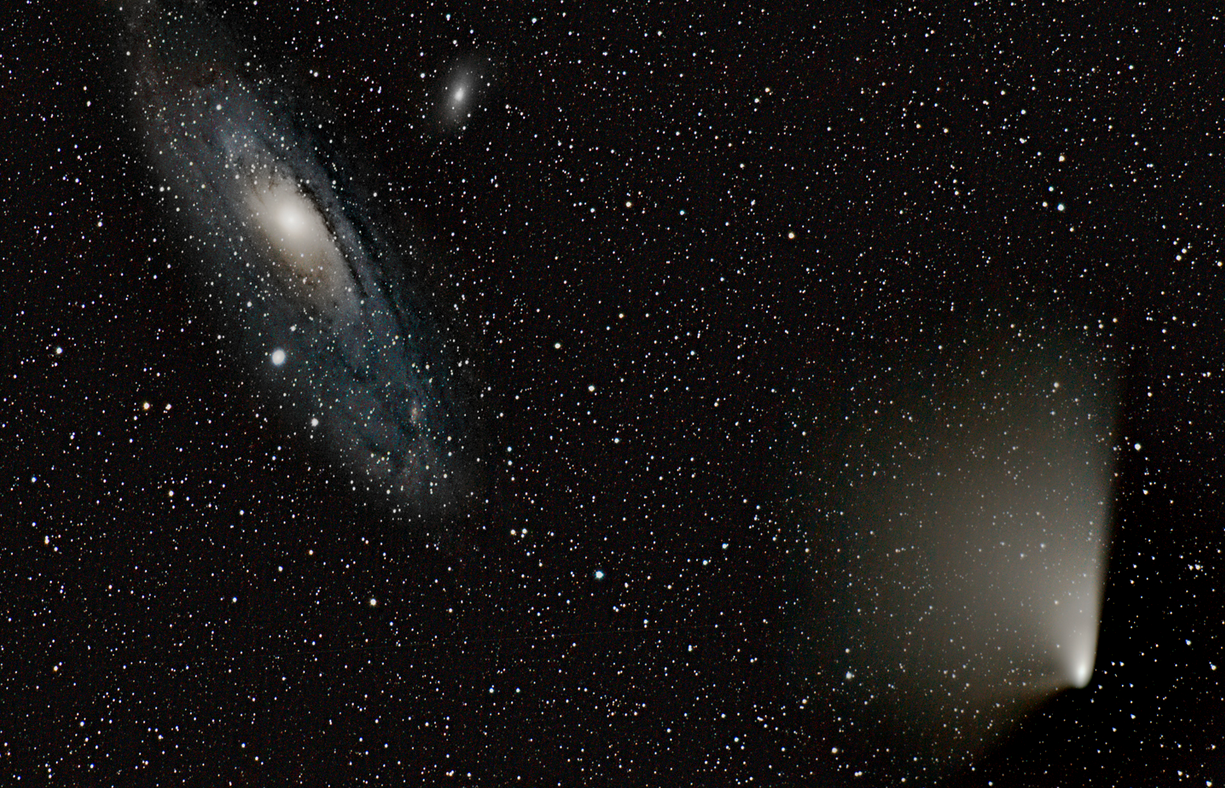Pan-STARRS astronomer
The only book on astronomy at home had caught his attention for good. His intense interest led him to become an astronomer. He switched his home observatory in Modra for Hawaiian Islands, where he searches for dangerous asteroids atop of an extinct volcano. Slovak astronomer, discoverer of several comets, which unfortunately do not bear his name,
Peter Vereš.
 You work at the Astronomical Institute of the University of Hawaii in Honolulu, where you search for hazardous asteroids. This is undoubtedly the dream work of many astronomers. However every journey has its beginning. So what was your first encounter with astronomy?
You work at the Astronomical Institute of the University of Hawaii in Honolulu, where you search for hazardous asteroids. This is undoubtedly the dream work of many astronomers. However every journey has its beginning. So what was your first encounter with astronomy?
I don't remember the exact age, I was probably seven years old. But I remember having flu, soaking my feet in the warm water and having a blanked over my shoulders. I must have been late Fall or early Spring, because it was dark outside and TV news were not broadcast yet that evening. Thus, in such a situation, a child is bored easily. My Dad used to hand me a book from the upper shelf of the bookcase. There were heavier books, about ocean voyages, history, plants and animals.
That evening I got a book that probably changed my life. "Obloha na dlani" (The Sky in the palm) written by Eduard Pittich and Dušan Kalmančok became the first book about the astronomy I have ever read and the only one that we had at home. Although I did not understand large fraction of its content at that age, it dragged my attention and I started to investigate what all those foreign words about the space mean.
Most professional astronomers begins as an amateur, how was it with you?
Except of binoculars we did not have astronomical telescope at home. My Dad constructed a simple scope from hard paper tubes and lenses and I was able to observe Moon with it. Fortunately, Žilina, the town I come from, has a public observatory and I started to attend it. There I had my chance to observe objects through an eyepiece of the real telescope. I was eager to see all objects that I learned about in books and I often requested to see targets that were not in the usual schedule of the public viewing. Later, I acquired a custom eyepiece that suited an old 70 mm camera lens from the Soviet camera and with borrowed wooden tripod and a book with deep sky objects in a reach of an amateur telescope I often went out and looked at them.
At a high school I started to observe meteors visually and attended
attended few amateur observing campaigns of Perseids. Meteors were the topic of
my Highschool Research Activity (SOČ) project as well and I got it all the way
to the all-state round of the competition. Since then, my interests in astronomy
started to be focused on nearby objects - asteroids, comets and the debris that
was left after them.
Many of those who finally did not decided to be a professional astronomer and preferred a different career instead, were concern about finding a job in studied field after their graduation, or preferred financially better paid professions. Did you have a similar dilemma?
The tradeoff between the income and career in science or astronomy is obvious and present also in the countries like United States. The dilemma is always there and I never say never to an option that I will leave the science. Especially nowadays, when private companies start to explore space for commercial space flights, asteroid discovery and mining. Therefore, I still have this dilemma. But, I have never regretted that I followed this career path and even doing degree in science and having job in academia gives me a very good chance getting a great job in industry or private sector. On the other hand, work in science gives me more freedom and independence and a chance to teach future scientists.
Have not you thought about choosing other profession?
During the years at the Faculty of Mathematics, Physics and Informatics at the Comenius University I was considering working in other fields as well. Although the astronomy was the main reason why I enrolled into this faculty, there were additional fields I liked as well. I was considering nuclear physics, geophysics, meteorology and later I found out that the experimental physics and condense matter physics represent a very useful field in which one can easily get into industry as a highly qualified specialist. I also took classes on economics to get a background from a different field to broaden my horizons. I even worked for a software company for almost a year and got a job offer at the grant agency that I later denied.
What was your idea about astronomer work at the time, when you were deciding on future profession?
I had two impressions of being an astronomer - first was an observer: a scientist who observes the night sky through a telescope, analyzes the data, discovers objects. The second was a theoretical physicist: a profession that uses observational data to alter or improve existing theories and hypotheses. I always wanted to do observational astronomy with a reasonable combination of theory. Ideally, using own observational data to derive properties of objects and develop new theories.
In fact, many of that did not happen during my study - the lectures were focused
on theory with minimum observations and often lacked the latest discoveries. It's clear that before doing observations significant theoretical background is needed, mainly from higher mathematics, physics, programming, astronomy and astrophysics.
I would say the study of astronomy in Slovakia is mainly focused on theory
and lacks practical astronomy. However, in more developed, students have access to big astronomical instruments and are even able to observe on largest telescopes, working more on science with collaborators and senior scientists. However, they may lack some knowledge that we get from the theoretical background. That is why I was extremely happy and lucky I could observe during my grad school in Slovakia at the Astronomical and Geophysical observatory of the Comenius University in Modra for two years as a regular observer and at the same time I was finishing my dissertation thesis. I got observing experience that most classmates did not have.
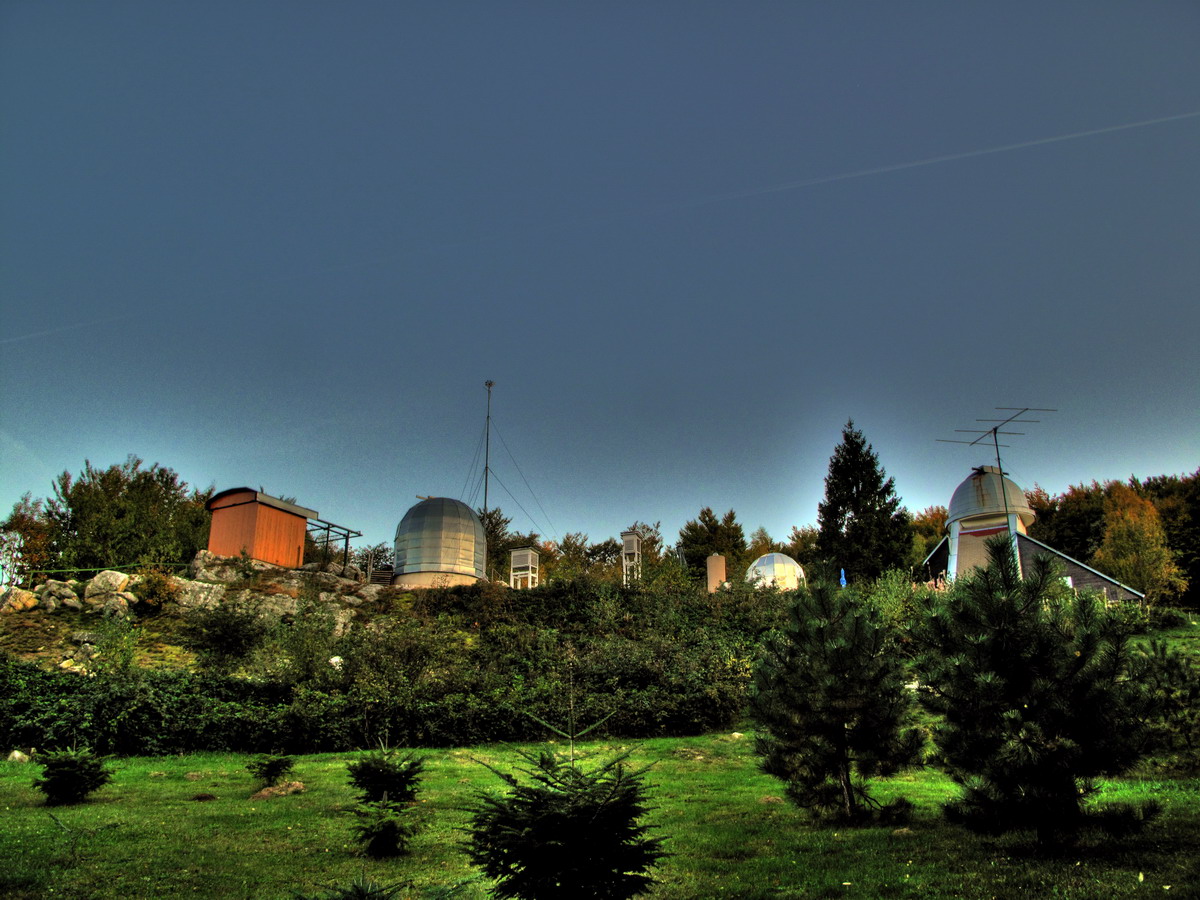
Foto: P. Veres
You had graduated with a major in Astronomy and you subsequently started your doctoral studies. Meanwhile, even as a university student you attended
the MACE 2006 conference in Vienna, dedicated to asteroids and comets research. Was it your first participation in conference abroad?
MACE was a relatively small conference of semi-professional and professional
astronomers from Europe. It covered minor bodies of the Solar system. For me it
was a first time when I attended such an event and right there I gave my first
talk where I presented results of my master thesis.
In fact, I was probably the first student of astronomy at Comenius University, who wanted to go abroad,
to achieve something and present it. Until then, virtually none of the students
were attending international conferences. I guess I was lucky young fellow who was aggressive and courageous to join "old professors".
Was the MACE conference useful for you?

The good part being at conferences is to see people whose names I know from papers in person, a possibility talking to them, asking questions and listening to their talks. Conversion is also very crucial because you never know when a new idea can cross someone's mind after a discussion. This often creates international cooperations, friendships, contributions on grants and future possibilities.
Besides research work you translated several books from the
English to Slovak. How did you get to this work?
I was just asked if I am interested in translating a popular book about astronomy for children. I agreed.
I wanted to have a new experience and I also appreciated that books and texts regarding
science and space are translated or at least consulted with scientists. Because, no matter how good the interpreter is, without a good knowledge of a field, the translation and meaning of words could really turn bad and into a nonsense. Still, it's not an easy job. One has not just to translate words but also compose meaningful sentences and phrases.
Translation requires a very good knowledge of English. For such a language proficiency would not be sufficient few English lessons in school. How did you achieved such a high level of English knowledge?
I have learned English since I was 9 years old. However, as kids we lacked of good teachers or native speakers. Even when we knew the grammar and little stylistics, we had almost no experience with a conversation, reading English books or listening to a broadcasting or watching a movie. Nowadays, I think all these are available and it is clearly easier for anyone to learn a foreign language. For me the best school was reading scientific papers in English, traveling around the world, attending conferences, giving talks and spending months (and later years) abroad.
In 2010 you were in the team that was looking for and also found meteorite fragments, later known as meteorite Košice. One of the lucky finders was you. What did you feel holding in your hand a piece of stone that recently circled around our Sun?
 While doing research at the Comenius University, writing master and dissertation theses, our team has been developing automated video system for all-sky detection of meteors and their orbit calculation. Nowadays the network
consists of 3 identical ground based systems. In addition to physical and orbital characteristics of meteors, the system can also provide crucial information in case the terminal mass of a meteoroid is not zero. Within last few years, there were few meteor falls in Slovakia, however, all of them provided only small fragments of a mass from few grams to hundreds of grams, all falling into a difficult terrain. We organized few recovery expeditions but none of them was successful.
While doing research at the Comenius University, writing master and dissertation theses, our team has been developing automated video system for all-sky detection of meteors and their orbit calculation. Nowadays the network
consists of 3 identical ground based systems. In addition to physical and orbital characteristics of meteors, the system can also provide crucial information in case the terminal mass of a meteoroid is not zero. Within last few years, there were few meteor falls in Slovakia, however, all of them provided only small fragments of a mass from few grams to hundreds of grams, all falling into a difficult terrain. We organized few recovery expeditions but none of them was successful.
Except of the extraordinary case near Košice, where the terminal mass was in order of magnitude greater that we were used to and the fall ellipse large, in relatively accessible terrain. It was a wonderful experience and success and I personally found three small fragments. We handled all samples very carefully, with gloves, put them into plastic bags and stored in dry environment. We also tried not to damage the fresh burned layer of each sample. Fresh meteorites are very rare - at the time of this fall, only 14 meteorites in the history had been found based on the atmospheric trajectory and the orbit was computed. Fresh samples are still not contaminated by microorganisms, Earth weathering and radiation and provide pristine sample of ancient pieces that formed the Solar system.
You are on a postdoctoral fellowship at University of Hawaii since the summer of 2011,
where you work with the Pan-STARRS telescope. But you already stayed at the same
institution for six months in 2008. How did you get the job there?
When studying as a graduate student, I actively looked for winter and summer
schools of astronomy and conferences. What was pretty normal and desirable in
developed countries was a new thing in Slovakia - it was a rare occasion that a
student got a chance to spend some time abroad or go to a conference. I was lucky
and active enough to get funding and visited few summer and winter schools in Italy
and Japan and even presented my results at conferences. In 2008 I got funding from SAIA to
spend 6 months in the United States and I found a collaborator at the University
of Hawaii.

Foto: P. Vereš
At that time they were developing the Pan-STARRS telescope and because my master thesis was about a proposal of a simple survey telescope for discovering asteroids in the close near-Earth vicinity, working for a world's largest survey was a challenge. In Hawaii I made simulations on how good the Pan-STARRS telescope would be in discovering direct Earth-impacting asteroids and published a paper that become a part of my dissertation thesis. After I finished my PhD in Slovakia and almost a year working at the Comenius University in Bratislava, I applied for a job abroad and there was a job offer at the University of Hawaii again, at the Pan-STARRS telescope in the group searching for asteroids. It was a perfect match for me - working with the same people, on the same telescope with experience I already had.
Do you remember your first sight of the southern sky?
I've actually never seen the southern sky entirely. The southernmost latitude I've ever been is Hawaii, which is only slightly below the Tropic of Cancer. From here I could see Scorpion entirely, Southern Cross or Centaurus. For the first time it was in 2008. I also remember the feeling having Sun right above my head at noon and casting no shadow at all!
What are your main tasks at work?
My goal was to improve the description of trails that moving asteroids make in Pan-STARRS images and developing a piece of software for doing that. I also spent some time in describing and understanding photometry of Pan-STARRS asteroids and comets. Meanwhile, I am in the discovery team of asteroids and comets. So far we have discovered more than 600 Near-Earth asteroids, 38 comets and more than 10,000 asteroids in the main belt. Currently, I am using the Pan-STARRS photometry (which is the best-ever in term of precision of all existing and previous surveys) of asteroids to derive better sizes and slope parameter of known asteroids.
How looks like your common working day?
In the morning I usually preview the fresh data from the Pan-STARRS telescope and
look for new asteroid discoveries. The process is mostly automatic, however, the
human interaction is still needed. When we see a new candidate, we post in on NEO
confirmation web site and wait for other astronomers for confirmation. We also
have own follow-up capabilities, thanks to the
CFHT (Canada-France-Hawaii Telescope)
and
UH2.2 (University of Hawaii 2.2-meter telescope)
on Mauna Kea. However, due to weather and technical reasons, we can not do the follow-up every time and are always grateful for other observatories' work. Still, sometimes it happens that objects that are too faint are not in the reach of other telescopes and we might lose them.
The rest of the time we have meetings with colleagues, discussing science and technical issues and time for doing science and writing actual scientific papers. Because I work at one of the biggest astronomical institutes in the world, there are always colloquia, guest speeches and student talks that I attend. From time to time I travel to attend a conference where I present results of my work.
You said that CCD images are processing by software, which obviously does not
identify all moving objects. Thousands of CCD images acquired during the night
can not be checked visually. What about utilize experienced amateurs which could look for objects that you automatic system missed?
Indeed, the Pan-STARRS image processing pipeline handles millions of detections every night. That includes false detections like diffraction spikes, flares, artifacts and glares that occur in such a wide-field optical assembly. The camera itself is a composite of 64 x 64 highly depleted CCD devices, each of them consisting of 600x600 pixels. That is why the image is a composite, having chip gaps obscuring a portion of the field of view. Moving objects are assessed by the Moving Object Processing Pipeline which is very efficient in linking moving objects and identifying known objects. However, due to the large contamination of data with false detections, several filtering mechanisms are in place.
Still, trained human eye can detect even fainter objects. Typically, when
observing near opposition, we see up to ten thousand asteroids within one hour of observation. Currently, when observing fields in the Solar System Survey, one of typically twenty fields is offered for visual previewing within our public outreach program with
International Astronomical Search Collaboration (IASC),
where high-school students can blink images and discover asteroids that our
software did not catch. Nowadays, raw data and data products are still not released, but in the future I assume the enormous archive of Pan-STARRS images would be available for data mining.
Your office is in Honolulu, the capital of the Hawaiian Islands and the Pan-STARRS telescope is located on the island of Maui, on top of Haleakala volcano. Several other telescopes are located atop of another volcano, Manua Kea, on the island of Hawaii. Are all these exclusively reserved for scientists, or can tourist visit them too?
Observatories on the tops of Maui and Hawaii are purely professional. Instruments there are among the largest and most expensive in the world. Their construction were always funded by several institutions or countries. As there are excellent observational conditions with large number of photometric nights, it is not appropriate for people to move around with flashlights or cars during the night. However, you can visit observatories on Mauna Kea by your own off-road vehicle. Every afternoon you can join the astronomer at the base camp, which takes visitors and show them at least one observatory from inside. The base camp is at the halfway to the volcano summit, at an altitude of 2800 meters above sea level and visitors are recommended to stay there at least for two hours due to acclimatization.
Furthermore to the information center with lots of souvenirs, focusing on astronomy, there are several amateur astronomers who observe the dark night sky every night. Base camp also provides accommodations for technicians and observers, office, dining and living rooms. Paradoxically, the naked eye can see more stars from the base camp, than from the top of Manua Kea. The human eye feels a lack of oxygen and sees much worse at altitudes 4000 m above sea level.
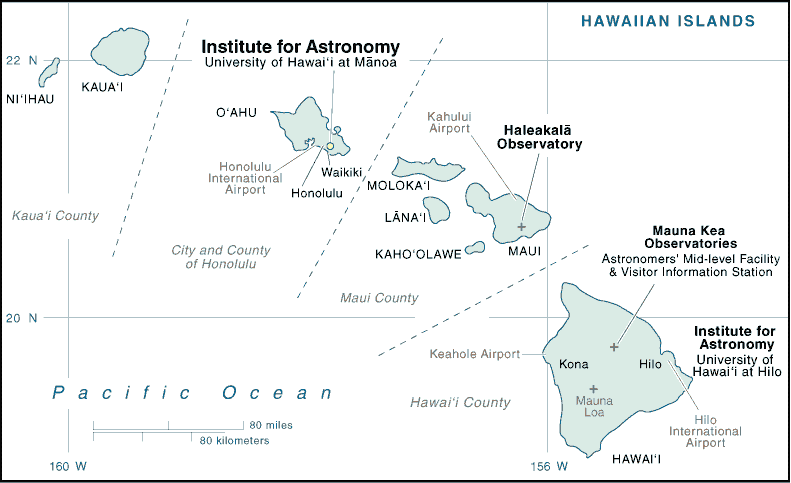
Foto: Institute of Astronomy, University of Hawaii
You can reach the top of Haleakala by excellent paved road which is open nonstop. That is a national park. The observatories do not have visitor center and whereas there are also military objects, your motion around observatories is monitored and you can see warning signs around there.
Since astronomy is very popular in USA, our Institute has a non-profit organization
Friends of IfA (Friends of the Institute for Astronomy),
which supports students and sponsors various activities for the public. We organize field trips to selected observatories and observation of the night sky
as a reward for our sponsors. This is also one of the ways how to visit Keck, Subaru and Gemini Telescope on Mauna Kea in person from close distance.
According to original plans a second Pan-STARRS telescope PS2 should be put into operation
this year. Will it be so and will we see all four telescopes in operation?
The PS2 telescope spotted its first light in the middle of July. The telescope is built and ready for first operation. I assume it will take half a year or a year to bring the telescope to the full operation. However, Pan-STARRS1 and Pan-STARRS2 are individual and identical telescopes, built in separate domes, next to each other. Although the original plan was to test the new technology on a single telescope and built a 4-aperture system on Mauna Kea, the current budget cuts and existing competition (LSST and the Thirty meter telescope), I don't think that the 4-telescope Pan-STARRS would ever happen a reality. Maybe if the LSST or the large-aperture project would not be feasible within next 10 years.
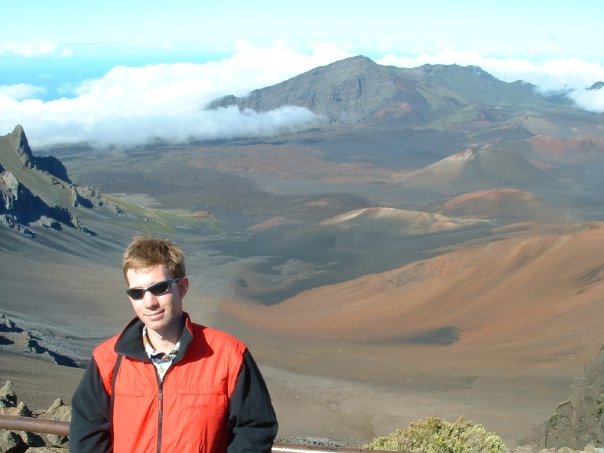
Foto: P. Veres archive
Since 2012, the Pan-STARRS is a leader in the number of Near-Earth Object (NEO) discoveries. Recently found new asteroid 2013 MZ5 turned out as a milestone - 10,000th NEO discovery. As this object was detected by Pan-STARRS team, perhaps it was you who spotted it first?
2013 MZ5 was reported by my colleague Bryce Bolin. Because of the amount of data, we divide the work between few people who preview the data in the morning. 2013 MZ5 turned out to be a typical Amor class NEO, not particularly interesting. It was moving almost from north to south at a relatively low declination (-26 deg), near the opposition. At the time of discovery it was about +21 mag, observed in 4 images within one hour.
Which is the most interesting object from Pan-STARRS discoveries?
For public the most interesting object so far was the comet C/2011 L4 Pan-STARRS that was visible by naked eye. We could also get the comet C/2012 S1 ISON, however, we found it later in pre-discovery images. From my perspective, interesting objects are those coming very close to the Earth, Centaurs and TNOs. We are also looking for fresh collisions between asteroids (haven't found a single one so far). Because of the nature of the project, Pan-STARRS discovered many brown dwarfs, observed exoplanets, lensing events in distance universe, etc.
In early March, when the comet C/2011 L4 Pan-STARRS became visible on the northern sky, many astronomers have tried to watch it. In the Southern Hemisphere you had this chance a little bit sooner. Did you catch it with naked eye?
I saw comet C/2011 L4 Pan-STARRS with my own eyes, when it became visible in the evening sky in Hawaii. We did observing for the public on the beach - nearly a thousand people came to watch the comet shortly after sunset, so we could see it too. Although it was visible to the naked eye, it was a special for astronomers only. We expect a greater show from comet C/2012 S1 ISON. Although, it was still very interesting to see the comet without a telescope, which we, as the first people ever, saw more than a year earlier as a little dot with a coma on CCD images.
Last year Slovak amateur astronomer Tomas Vorobjov discovered a new comet, do we have a chance that one day a comet Vereš will be added?
I don't have this chance. Pan-STARRS is a huge project and therefore, credit for
discoveries goes to the team, not to individuals. I discovered multiple comets by myself, however, all comets discovered by Pan-STARRS are named after the project (similar to SOHO or Catalina). Otherwise, the number of "newly discovered" comets, which could have born my name is 14, I also got 94 NEO discoveries and 4910 other asteroids.
Our planet is constantly bombarded from outer space. While the smallest particles bring us aesthetic experience in terms of meteors and fireballs, larger ones can already mean a local or even global catastrophe.
A new research program
ADAM (Automatic Detection of Asteroids and Meteorids) was created to look for such a dangerous objects at the Comenius University, your alma mater. Did you participated in its proposal?
Me and Juraj Tóth were actually authors of the project. I prepared and designed the system but I could not make it without the experience working on a real survey telescope. The project is different from the existing surveys - instead of looking for distant objects, we will observe brighter but closer objects flying in the Earth's vicinity. The idea was pretty old, Juraj Tóth came with it 10 years ago and I was his first student that took the master thesis with the topic of survey searching for small near-Earth asteroids. That time only few objects of that class were discovered and all by a random change. We wanted to search for them and determine the population size. We did not improve the idea since then very much and although working in the same field, I mostly concentrated on meteors coming from asteroids and later on Pan-STARRS survey.
European Scientific Council on the same day as the tiny asteroid flashed over
Chelyabinsk, refused to support your project. What will be the fate of your project,
which could be capable of capturing NEO objects escaped from other surveys?
Nowadays, we are searching for funds and applying for grants. In comparison to
existing surveys, this one will be order of magnitude cheaper but still significant
and able to deliver asteroid and comet discoveries, as well as many byproducts.
As soon as we get funds, we will be able to proceed, hire people, buy components
and prepare the site at the AGO Modra observatory. I also has a cooperation with
a very similar project (ATLAS) that obtained funds and is currently developed at
our institute in Hawaii. Thus, ATLAS is idea that is very similar to ours, it's
only few years old but astronomers were able to obtain funding much faster for it.
"Let´s find them!", was your final appeal of your talk on the above mentioned MACE meeting in Vienna. Can we ever reach this aim, to cover all dangerous asteroids and say that there are no more threat from the space?
Probably never. We can discover almost all asteroids larger than a given size in
a reasonable time frame, but there are always objects hiding in particular orbits
that are very hard to find. In next decade there will be telescopes in the orbit
around the Earth or on heliocentric orbit (on close to Venus) searching for asteroids that could easily beat the ground based survey and enhance the completeness of NEO population. Still, the danger would still come from long periodic comets that we discover only few years before coming close to us.


